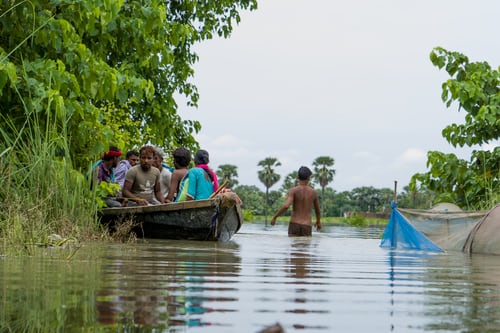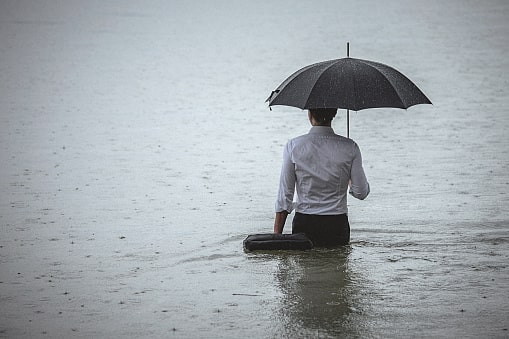Solutions to Bihar Floods Disaster
As per the United Nations, Office for Disaster Risk Reduction (UNDRR) 90 percent of extensive disasters have been caused by FLOODS, heatwaves, and other weather-related events in the last 20 years.
The announcement (report), named ‘The Human Cost of Weather-Related Disasters’ finds that the five countries INDIA, the United States, China, Philippines, and Indonesia stood by the greatest number of catastrophes.
Bihar, Assam, Uttar Pradesh, and West Bengal are the most FLOOD-Prone states. These states have been facing challenges with repetitive and enormous FLOODING every year.
We all know about the challenges and thereafter effect here we will focus on finding out solutions to particularly India-Nepal perennial FLOOD occurs in every consecutive year. Bihar comprises 16.5% of India’s FLOOD-Affected area and 22.1% of India’s FLOOD-Affected population.
REASONS FOR FLOODS IN BIHAR
Districts of Bihar and largely the districts of North Bihar (particularly Mithilanchal) are vulnerable to FLOOD during the monsoon season. Geographically Nepal is a mountainous region and some of Nepal’s biggest river systems originate in the Himalayan glaciers during the monsoon they flow into the plains and lowlands of Bihar making it one of India’s FLOOD-Prone regions.

Mainly these following rivers are causing FLOODS in Bihar.
- Ghaghra
- Gandak
- Budhi Gandak
- Bagmati
- Kamala
- Bhutani Balan
- Mahananda
- Kosi also called Sorrow of Bihar has 56 gates and the Kosi barrage has been built by India and Nepal in 1954 on the Kosi river to control the flow of river water and to ensure FLOOD management. Due to incessant rains on Nepal’s side, the barrage gate is frequently opened, which causes a lot of devastation in Bihar.

As per the NASA (National Aeronautics and Space Administration) ‘Precipitation Measurement Missions’ the rising temperature will intensify the earth’s water cycle, increasing evaporation as a result, the areas are inclined to undergo expansions in precipitation and increased risk of FLOODING.
11 SOLUTIONS TO THE INDIA-NEPAL FLOODS
- Need to replace Kosi barrage with the dam, the sustainability of the dam should be based on the HSAP (Hydropower Sustainability Assessment Protocol) which was developed in response to the report of the World Commission on Dams in 2020.
- Robust Disaster preparedness plan
- Climate change and rapid urbanization have resulted in urban water-related problems, such as FLOODING disasters, water pollution, and water shortages to tackle these issues, the concept of SPONGE CITY was put forward by China to Reduce FLOODS by absorbing rainwater.
- Forestation
- Providing life jackets with subsidized rates to the people of the FLOOD affecting regions.
- An INTERGOVERNMENTAL panel must be formed with local representation.
- High-Quality COORDINATION between the center and the state governments must be formed to prevent FLOODS.
- India and Nepal should reinstate the WATER DIALOGUE to protect the interests of all those who have been affected on both sides of the border due to perennial FLOODS in Bihar and Nepal’s Tarai region.
- Development of the infrastructure, building EMBANKMENTS, and DREDGING will be conclusive to mitigate the effects of the FLOODS in Bihar.
- In August 2004 in Nepal to address the problem of gigantic and recurrent FLOOD in Bihar the Joint Project Office (JPO) was rooted by India to prepare a detailed project report to construct a high dam on the Nepal side (on the Kosi, Kamla, and Bagmati rivers) but the detailed project report has been pending even after 17 years, the need of the hour is to expedite the process for its completion.
- As per the existing India-Nepal agreement on water resources, the state government is authorized to execute flood protection functions inside Nepal territory along the India-Nepal border but sometimes due to local resistance FLOOD protection works got delayed so Nepal must play its part in ensuring a sustainable way forward.
STEPS TAKEN BY THE GOVERNMENT OF INDIA FOR FLOOD MANAGEMENT

Based on the directions of the Taskforce 2004 for effective FLOOD management, the Union Government has been contributing central assistance to the State Governments for productive FLOOD supervision in crucial areas.
An Expert Committee was constituted by the Ministry of Water Resources in July 2012 for the Scientific Assessment of FLOOD-Prone areas in the country.
The Central Water Commission (CWC) is entrusted with the responsibility of coordination and furthering in consultation with the state governments concerned for FLOOD CONTROL, drinking water supply, etc.
The CWC (Central Water Commission ) functions under the Ministry of Jal Shakti. CWC enables state governments in devising and analyzing FLOOD control measures. They also tackle flash FLOOD forecasts.
